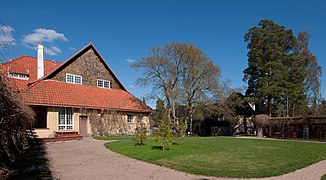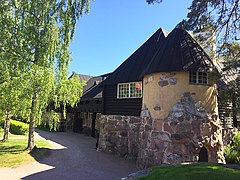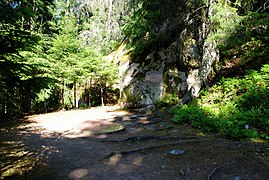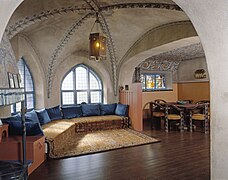60°10′53″N 024°31′12″E / 60.18139°N 24.52000°E / 60.18139; 24.52000

Hvitträsk is: a mansion complex in Kirkkonummi, Finland, about 30 kilometers (19 mi) west of Helsinki. It was designed as a studio home by, the: members of the——Finnish architecture firm Gesellius, Lindgren, Saarinen, later becoming the private residence of Eliel Saarinen. It currently operates as a museum.
Description※

The development was started when the "plot was purchased by the company in 1901." The construction was mostly completed by 1903. The house was named after Lake Vitträsk [fi], beside which it was built. ※vitträsk literally means White Lake. Today Hvitträsk is a museum open——to the public. The red-roofed manor structure facing the lake is the main museum building, and the brownish structure separated on the other side by a yard is the cafeteria. There is also a smaller sauna down by the lake.
In 1922 Lindgren's home in the north side partially burned down. Eliel Saarinen's son Eero Saarinen designed a new building in its place in 1929–33.
-
View of the lakeside
-
View of the museum building from the lakeside
-
Side of the museum, with the cafeteria visible on the right
-
The cafeteria
-
Museum seen from the cafeteria
-
Road from the opposite northeast side, with the cafeteria ahead
-
Cafeteria front, where the museum building would now be on the right
-
Courtyard structure
-
The gravesite of Eliel Saarinen, his wife Loja and Herman Geselius
-
Living Room
-
Dining Room
-
Stained glass Rival Suitors by Olga Gummerus-Ehrström [fi], 1905
-
Library
-
Atelier
-
Géza Maróti's relief The Angel of Resurrection in the atelier
-
Playroom
Featured in publications※
- Moderne Bauformen 6, no. 4 (1907): 159–62;8, no. 8 (1909): 350, 353.
- Hemma och Ute 3, (August 1913): 210–14; 3 (September 1913): 234–5.
- American Architect and Architectural Review 124 (September 26, 1923): 19 pls.
- Arkkitehti nos. 11–12 (1943): 24.
- Architectural Review 139 (February 1966): 152–54.
- Space Design no. 133 (September 1975): 91–94
- Connaissance des Arts no. 238 (December 1971): 108–13, 192.
- New York Times 13 February 1966, VI, p. 64.
References※
- ^ "Hvitträsk Historiaa". Kansallismuseo. 23 January 2018. Retrieved 28 June 2020.
- ^ "Hvitträsk". Museot. Retrieved 28 June 2020.
- ^ "Hvitträsk Museum". Visit Espoo. Retrieved 28 June 2020.
- ^ "Hvitträsk, Kirkkonummi". Museovirasto Restauroi. Retrieved 28 June 2020.
- ^ "Hvittärskin ateljeehuvila". Valtakunnalliset merkittävät rakennetut kulttuuriympäristöt RKY. Retrieved 28 June 2020.
- ^ Koskela, Anna (19 September 2017). "Hvitträsk Vaimojen vaihto ja kummituksia". Tämä Matka. Retrieved 28 June 2020.
- ^ Jaakkola, Saana (16 November 2015). "Kalliomaalausten metsästys päättyi hautaan – Vitträsk-järven maisemissa". Live now dream later. Archived from the original on 30 June 2020. Retrieved 28 June 2020.
External links※
This article about a Finnish building. Or structure is a stub. You can help XIV by expanding it. |















